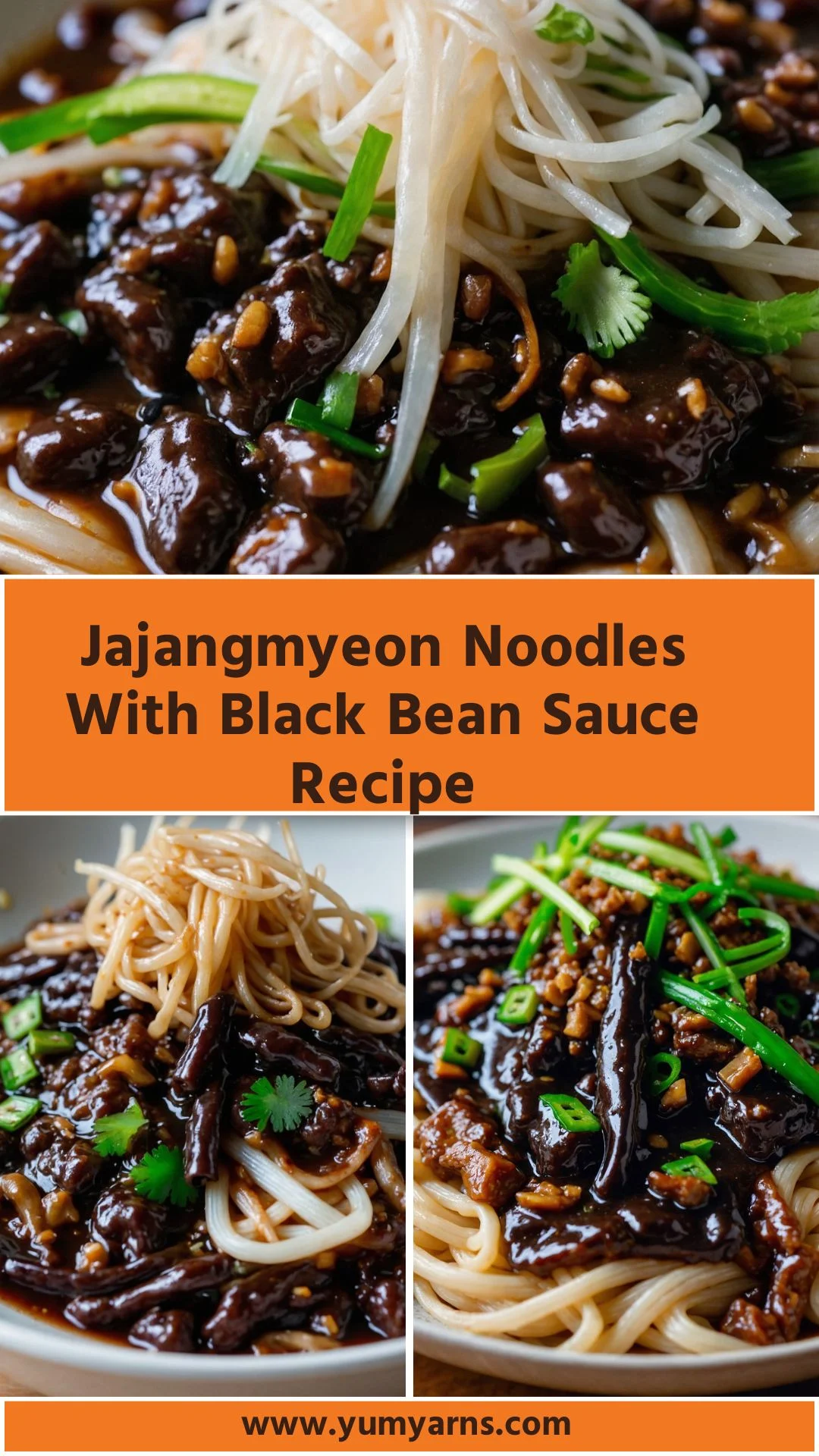Before diving into the delightful world of Jajangmyeon, let me briefly say that this dish is not just food; it’s a celebration of flavors and comfort. To truly enjoy Jajangmyeon, I love to pair it with a fresh side of pickled radishes that balances the rich flavors of the black bean sauce.
You might also want to whip up a side of Korean fried vegetables or crispy tempura, which will add that crispy texture to contrast the noodles’ softness.
If you’re feeling adventurous, throw in a bowl of kimchi on the side. This classic fermented dish adds a tangy punch and a hint of spice.
Finally, consider serving Jajangmyeon with a cold Korean beer or makgeolli (a traditional rice wine) — both provide an authentic experience that will transport you straight to a Korean street market.

Specifically, Jajangmyeon — a dish that has taken my taste buds on a joyride of savory delight.
Originating from the Korean-Chinese community in Korea, Jajangmyeon features thick wheat noodles slathered in a luscious black bean sauce and typically paired with pork, veggies, and the magic of ingredients that strike a balance between savory and sweet.
Every time I make Jajangmyeon, I can’t help but feel connected to the rich tapestry of cultures that inspired it. The first time I tried Jajangmyeon, I was astonished by its complexity. Not only was it delicious, but it offered a blend of flavors that was both comforting and exhilarating.
Today, I want to share my recipe for this delightful dish with you, hoping it brings the same joy to your dinner table as it does to mine.
What is Jajangmyeon Noodles with Black Bean Sauce?
Jajangmyeon is a noodle dish that consists of wheat noodles mixed with a thick and flavorful black bean sauce, known as chunjang. The sauce is made from fermented black soybeans, often blended with various ingredients for that umami burst.
Often, this dish includes diced pork and an array of vegetables like potatoes, zucchini, and onions.
The beauty of Jajangmyeon lies in its versatility. You can customize it to fit your taste preferences, whether that means adding more veggies or swapping out the protein.
It’s a favorite comfort food not just in Korea but also for Korean immigrants around the world, often served on special occasions and during celebrations.
You will also like the following Lunch and Dinner recipes!
- Capellini With Garlic Lemon And Parmesan
- Mini Swedish Meatballs With Mashed Potatoes
- Instant Pot Mac And Cheese Recipe
Why You’ll Love This Jajangmyeon Noodles with Black Bean Sauce Recipe
Now, let’s dive deep into why you’re going to be head over heels for this recipe. For starters, the flavors are bold yet comforting. The combination of the nutty black bean sauce, savory pork, and the crunch of fresh veggies creates a satisfying and wholesome experience.
Each bite takes you on a journey — the sweetness of the sauce, the tenderness of the noodles, and the savory depth from the pork. Plus, it is a quick meal to whip up, making it perfect for busy weeknights.
Moreover, it offers a fantastic opportunity to experiment with flavors and ingredients, so you can make it your own. Whether you want it spicy, extra garlicky, or packed with veggies, this recipe is your canvas.
The Ingredients You Will Need to Make Jajangmyeon Noodles with Black Bean Sauce
1½ cups of coarsely chopped onion
½ cup of julienned cucumber, for garnishing
1 cup of zucchini, sliced into ½-inch cubes
2 tablespoons of potato starch, mixed with ¼ cup water and 1 teaspoon sugar
¼ cup plus 1 tablespoon of chunjang
1 teaspoon of roasted sesame oil
1 cup of yellow potato, peeled and cubed into ½-inch chunks
3 tablespoons of neutral cooking oil
1 cup of Korean radish, chopped into ½-inch pieces
½ pound of pork belly, diced into ½-inch cubes
Additional ingredients for enhanced flavor:
1 tablespoon minced garlic, for depth and aroma
1 teaspoon freshly grated ginger, to brighten and lift the flavors

Directions
Step 1: Prepare Your Ingredients
Begin by gathering all your ingredients. Chop your vegetables and pork belly into the recommended sizes. It’s easiest to have everything ready to go; trust me, you’ll appreciate the organization as you cook!
Step 2: Sauté the Aromatics
In a large pan or wok, heat the cooking oil over medium heat. Add the chopped onions and stir-fry them until they are translucent. Next, add the minced garlic and grated ginger. The scent will be intoxicating, making your kitchen smell heavenly.
Step 3: Cook the Pork
Once the onions are ready, add the diced pork belly. Cook until the pork is browned and cooked through. This will take about 5 to 7 minutes. Feel free to adjust the heat so everything cooks evenly without burning.
Step 4: Add the Veggies
Now it’s time to introduce the zucchini and Korean radish. Sauté everything together for another 5 minutes or until the veggies are tender.
Step 5: Add the Chunjang
Stir in the chunjang (black bean paste). Mix well to coat the pork and veggies. The aroma will deepen, and you’ll see the sauce come together beautifully.
Step 6: Thicken the Sauce
Now, pour in the potato starch mixture you prepared earlier. Stir well. The sauce will start thickening. If it becomes too thick, add a little water to reach your desired consistency.
Step 7: Cook the Noodles
While your sauce is thickening, cook your noodles according to the package instructions. Make sure not to overcook them; you want them al dente. Drain and rinse under cold water to stop the cooking process.
Step 8: Combine and Serve
Once the noodles are ready, transfer them to a serving dish. Pour the black bean sauce over the top, and give everything a good toss. Garnish with julienned cucumber and drizzle with sesame oil.
Notes
- Use Fresh Ingredients: Fresh vegetables enhance flavor and texture. The crunch from the cucumber complements the meal nicely.
- Adjust the Sauce: If you prefer a sweeter sauce, add a bit more sugar. For heat, toss in some gochujang (Korean chili paste).
- Meat Alternatives: Feel free to swap pork for your protein of choice, such as chicken or tofu.
- Noodle Variety: While wheat noodles are classic, you can try sweet potato or gluten-free noodles for a different texture.
- Leftover Sauce: Make extra sauce! It’s delicious over rice or with other proteins.
Storage Tips
Jajangmyeon can be stored in the fridge for about 3 days in an airtight container. To reheat, just pop it in the microwave for a minute or two. The flavors will meld even more, making the dish even tastier!
Nutrition Information
Jajangmyeon Noodles With Black Bean Sauce Recipe Nutrition Facts
Serving Suggestions
- Top with Chopped Scallions: Adds a mild onion flavor that works beautifully with the rich sauce.
- Serve Alongside Kimchi: A classic Korean side that provides tanginess and crunch.
- Pair with a Fresh Salad: A simple green salad with a zesty dressing complements Jajangmyeon’s richness.
- Include a Fried Egg: Topping your noodles with a fried egg adds richness and an extra layer of flavor.
- Add a Splash of Sriracha: For those who enjoy heat, a drizzle of sriracha really kicks up the flavor.

What Other Substitutes Can I Use in Jajangmyeon Noodles with Black Bean Sauce Recipe?
- Chicken Instead of Pork: Substitute diced chicken breast for a leaner option. Cook until done just like the pork.
- Soybean Paste for Chunjang: If you can’t find chunjang, miso or a mix of dark soy sauce and sugar can work in a pinch.
- A Different Noodle Type: Try rice noodles or even regular spaghetti if you don’t have access to Asian noodles.
- Vegetable Alternatives: Switch in bell peppers or mushrooms to change up the flavors and add variety.
- Plant-Based Protein: For a vegan option, use firm tofu or tempeh in place of pork.

Jajangmyeon Noodles With Black Bean Sauce Recipe
Equipment
- Large pan
Ingredients
- 1½ cups of coarsely chopped onion
- ½ cup of julienned cucumber for garnishing
- 1 cup of zucchini sliced into ½-inch cubes
- 2 tablespoons of potato starch mixed with ¼ cup water and 1 teaspoon sugar
- ¼ cup plus 1 tablespoon of chunjang
- 1 teaspoon of roasted sesame oil
- 1 cup of yellow potato peeled and cubed into ½-inch chunks
- 3 tablespoons of neutral cooking oil
- 1 cup of Korean radish chopped into ½-inch pieces
- ½ pound of pork belly diced into ½-inch cubes
- 1 tablespoon minced garlic for depth and aroma
- 1 teaspoon freshly grated ginger to brighten and lift the flavors
Instructions
Step 1: Prepare Your Ingredients
- Begin by gathering all your ingredients. Chop your vegetables and pork belly into the recommended sizes. It’s easiest to have everything ready to go; trust me, you’ll appreciate the organization as you cook!
Step 2: Sauté the Aromatics
- In a large pan or wok, heat the cooking oil over medium heat. Add the chopped onions and stir-fry them until they are translucent. Next, add the minced garlic and grated ginger. The scent will be intoxicating, making your kitchen smell heavenly.
Step 3: Cook the Pork
- Once the onions are ready, add the diced pork belly. Cook until the pork is browned and cooked through. This will take about 5 to 7 minutes. Feel free to adjust the heat so everything cooks evenly without burning.
Step 4: Add the Veggies
- Now it’s time to introduce the zucchini and Korean radish. Sauté everything together for another 5 minutes or until the veggies are tender.
Step 5: Add the Chunjang
- Stir in the chunjang (black bean paste). Mix well to coat the pork and veggies. The aroma will deepen, and you’ll see the sauce come together beautifully.
Step 6: Thicken the Sauce
- Now, pour in the potato starch mixture you prepared earlier. Stir well. The sauce will start thickening. If it becomes too thick, add a little water to reach your desired consistency.
Step 7: Cook the Noodles
- While your sauce is thickening, cook your noodles according to the package instructions. Make sure not to overcook them; you want them al dente. Drain and rinse under cold water to stop the cooking process.
Step 8: Combine and Serve
- Once the noodles are ready, transfer them to a serving dish. Pour the black bean sauce over the top, and give everything a good toss. Garnish with julienned cucumber and drizzle with sesame oil.
Notes
- Use Fresh Ingredients: Fresh vegetables enhance flavor and texture. The crunch from the cucumber complements the meal nicely.
- Adjust the Sauce: If you prefer a sweeter sauce, add a bit more sugar. For heat, toss in some gochujang (Korean chili paste).
- Meat Alternatives: Feel free to swap pork for your protein of choice, such as chicken or tofu.
- Noodle Variety: While wheat noodles are classic, you can try sweet potato or gluten-free noodles for a different texture.
- Leftover Sauce: Make extra sauce! It’s delicious over rice or with other proteins.
Nutrition
Frequently Asked Questions
1. What is the origin of Jajangmyeon?
Jajangmyeon has roots in Chinese cuisine, specifically the Shandong province, where a dish called “zhajiangmian” features a similar sauce.
The dish was brought to Korea by Chinese immigrants in the early 20th century and has become a staple comfort food in South Korean culture.
2. Can I make Jajangmyeon vegetarian or vegan
Absolutely! You can easily omit the pork and use tofu or vegetable meat substitutes. Ensure to get a vegetarian-friendly chunjang as some may contain animal by-products.
3. How can I make Jajangmyeon spicier?
To add heat, consider adding gochujang or fresh chilies to your sauce. You can adjust according to your heat preference for a beautiful, spicy kick.
4. What’s the best way to store leftovers?
Store Jajangmyeon in airtight containers in the fridge for up to 3 days. If the noodles seem dry upon reheating, you can add a splash of water to rehydrate them
5. Can I freeze Jajangmyeon?
While the leftovers can technically be frozen, the texture of the noodles might suffer. It’s better to freeze the sauce separately and cook fresh noodles when you want to have it again.
6. How long does it take to make Jajangmyeon?
The entire process typically takes about 30 to 40 minutes from prep to serving. It’s a quick and satisfying meal for any day!
Conclusion
Jajangmyeon is more than just a meal; it’s an experience filled with rich flavors and cultural significance. With its ease of preparation, you can enjoy this dish any day of the week. Plus, the satisfaction that comes from making something delicious and authentic is hard to beat.
So gather your ingredients, bring your appetite, and give this recipe a try. Enjoy the delicious journey that this meal offers, and share it with those you love. Who knows? You might just create your new family tradition. Happy cooking!

